+ Open data
Open data
- Basic information
Basic information
| Entry | Database: PDB / ID: 6h3c | ||||||
|---|---|---|---|---|---|---|---|
| Title | Cryo-EM structure of the BRISC complex bound to SHMT2 | ||||||
 Components Components |
| ||||||
 Keywords Keywords | SIGNALING PROTEIN / Deubiquitinase complex / DUB / Lysine-63 linkage specific / BRCC36-containing / BRCA1A binding | ||||||
| Function / homology |  Function and homology information Function and homology informationperoxisome targeting sequence binding / BRISC complex / formate biosynthetic process / L-allo-threonine aldolase activity / BRCA1-A complex / regulation of mitochondrial translation / glycine metabolic process / attachment of spindle microtubules to kinetochore / L-serine metabolic process / regulation of oxidative phosphorylation ...peroxisome targeting sequence binding / BRISC complex / formate biosynthetic process / L-allo-threonine aldolase activity / BRCA1-A complex / regulation of mitochondrial translation / glycine metabolic process / attachment of spindle microtubules to kinetochore / L-serine metabolic process / regulation of oxidative phosphorylation / L-serine biosynthetic process / nuclear ubiquitin ligase complex / glycine hydroxymethyltransferase / glycine hydroxymethyltransferase activity / glycine biosynthetic process from L-serine / Metabolism of folate and pterines / Hydrolases; Acting on peptide bonds (peptidases); Omega peptidases / tetrahydrofolate metabolic process / response to type I interferon / regulation of DNA damage checkpoint / mitotic G2/M transition checkpoint / tumor necrosis factor receptor binding / protein K63-linked deubiquitination / tetrahydrofolate interconversion / metal-dependent deubiquitinase activity / regulation of aerobic respiration / K63-linked deubiquitinase activity / response to ionizing radiation / amino acid binding / hematopoietic stem cell proliferation / DNA repair-dependent chromatin remodeling / positive regulation of NLRP3 inflammasome complex assembly / mitotic G2 DNA damage checkpoint signaling / mitochondrial nucleoid / RHOG GTPase cycle / polyubiquitin modification-dependent protein binding / protein deubiquitination / mitotic spindle assembly / response to X-ray / ubiquitin ligase complex / regulation of DNA repair / enzyme regulator activity / one-carbon metabolic process / Mitochondrial protein degradation / positive regulation of DNA repair / response to ischemia / cellular response to ionizing radiation / chromosome segregation / protein tetramerization / Nonhomologous End-Joining (NHEJ) / G2/M DNA damage checkpoint / Metalloprotease DUBs / metallopeptidase activity / spindle pole / pyridoxal phosphate binding / double-strand break repair / mitotic cell cycle / Recruitment and ATM-mediated phosphorylation of repair and signaling proteins at DNA double strand breaks / microtubule cytoskeleton / chromatin organization / Processing of DNA double-strand break ends / protein homotetramerization / microtubule binding / microtubule / cysteine-type deubiquitinase activity / mitochondrial inner membrane / nuclear body / ciliary basal body / mitochondrial matrix / cell division / positive regulation of cell population proliferation / apoptotic process / DNA damage response / chromatin binding / negative regulation of apoptotic process / signal transduction / mitochondrion / proteolysis / extracellular exosome / nucleoplasm / metal ion binding / identical protein binding / nucleus / cytosol / cytoplasm Similarity search - Function | ||||||
| Biological species |  Homo sapiens (human) Homo sapiens (human) | ||||||
| Method | ELECTRON MICROSCOPY / single particle reconstruction / cryo EM / Resolution: 3.9 Å | ||||||
 Authors Authors | Bunker, R.D. / Rabl, J. / Thoma, N.H. | ||||||
 Citation Citation |  Journal: Mol Cell / Year: 2019 Journal: Mol Cell / Year: 2019Title: Structural Basis of BRCC36 Function in DNA Repair and Immune Regulation. Authors: Julius Rabl / Richard D Bunker / Andreas D Schenk / Simone Cavadini / Mark E Gill / Wassim Abdulrahman / Amparo Andrés-Pons / Martijn S Luijsterburg / Adel F M Ibrahim / Emma Branigan / ...Authors: Julius Rabl / Richard D Bunker / Andreas D Schenk / Simone Cavadini / Mark E Gill / Wassim Abdulrahman / Amparo Andrés-Pons / Martijn S Luijsterburg / Adel F M Ibrahim / Emma Branigan / Jacob D Aguirre / Aimee H Marceau / Claire Guérillon / Tewis Bouwmeester / Ulrich Hassiepen / Antoine H F M Peters / Martin Renatus / Laurent Gelman / Seth M Rubin / Niels Mailand / Haico van Attikum / Ronald T Hay / Nicolas H Thomä /      Abstract: In mammals, ∼100 deubiquitinases act on ∼20,000 intracellular ubiquitination sites. Deubiquitinases are commonly regarded as constitutively active, with limited regulatory and targeting capacity. ...In mammals, ∼100 deubiquitinases act on ∼20,000 intracellular ubiquitination sites. Deubiquitinases are commonly regarded as constitutively active, with limited regulatory and targeting capacity. The BRCA1-A and BRISC complexes serve in DNA double-strand break repair and immune signaling and contain the lysine-63 linkage-specific BRCC36 subunit that is functionalized by scaffold subunits ABRAXAS and ABRO1, respectively. The molecular basis underlying BRCA1-A and BRISC function is currently unknown. Here we show that in the BRCA1-A complex structure, ABRAXAS integrates the DNA repair protein RAP80 and provides a high-affinity binding site that sequesters the tumor suppressor BRCA1 away from the break site. In the BRISC structure, ABRO1 binds SHMT2α, a metabolic enzyme enabling cancer growth in hypoxic environments, which we find prevents BRCC36 from binding and cleaving ubiquitin chains. Our work explains modularity in the BRCC36 DUB family, with different adaptor subunits conferring diversified targeting and regulatory functions. | ||||||
| History |
|
- Structure visualization
Structure visualization
| Movie |
 Movie viewer Movie viewer |
|---|---|
| Structure viewer | Molecule:  Molmil Molmil Jmol/JSmol Jmol/JSmol |
- Downloads & links
Downloads & links
- Download
Download
| PDBx/mmCIF format |  6h3c.cif.gz 6h3c.cif.gz | 1 MB | Display |  PDBx/mmCIF format PDBx/mmCIF format |
|---|---|---|---|---|
| PDB format |  pdb6h3c.ent.gz pdb6h3c.ent.gz | 863.7 KB | Display |  PDB format PDB format |
| PDBx/mmJSON format |  6h3c.json.gz 6h3c.json.gz | Tree view |  PDBx/mmJSON format PDBx/mmJSON format | |
| Others |  Other downloads Other downloads |
-Validation report
| Summary document |  6h3c_validation.pdf.gz 6h3c_validation.pdf.gz | 1.1 MB | Display |  wwPDB validaton report wwPDB validaton report |
|---|---|---|---|---|
| Full document |  6h3c_full_validation.pdf.gz 6h3c_full_validation.pdf.gz | 1.1 MB | Display | |
| Data in XML |  6h3c_validation.xml.gz 6h3c_validation.xml.gz | 91.6 KB | Display | |
| Data in CIF |  6h3c_validation.cif.gz 6h3c_validation.cif.gz | 141.8 KB | Display | |
| Arichive directory |  https://data.pdbj.org/pub/pdb/validation_reports/h3/6h3c https://data.pdbj.org/pub/pdb/validation_reports/h3/6h3c ftp://data.pdbj.org/pub/pdb/validation_reports/h3/6h3c ftp://data.pdbj.org/pub/pdb/validation_reports/h3/6h3c | HTTPS FTP |
-Related structure data
| Related structure data |  0132MC 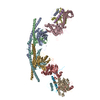 6gvwC C: citing same article ( M: map data used to model this data |
|---|---|
| Similar structure data |
- Links
Links
- Assembly
Assembly
| Deposited unit | 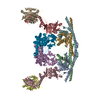
|
|---|---|
| 1 |
|
- Components
Components
-Protein , 3 types, 6 molecules AFBGEJ
| #1: Protein | Mass: 49256.246 Da / Num. of mol.: 2 Source method: isolated from a genetically manipulated source Source: (gene. exp.)  Homo sapiens (human) / Gene: ABRAXAS2, ABRO1, FAM175B, KIAA0157 / Cell line (production host): High Five / Production host: Homo sapiens (human) / Gene: ABRAXAS2, ABRO1, FAM175B, KIAA0157 / Cell line (production host): High Five / Production host:  Trichoplusia ni (cabbage looper) / References: UniProt: Q15018 Trichoplusia ni (cabbage looper) / References: UniProt: Q15018#2: Protein | Mass: 38417.402 Da / Num. of mol.: 2 Source method: isolated from a genetically manipulated source Source: (gene. exp.)  Homo sapiens (human) / Gene: BRCC3, BRCC36, C6.1A, CXorf53 / Cell line (production host): High Five / Production host: Homo sapiens (human) / Gene: BRCC3, BRCC36, C6.1A, CXorf53 / Cell line (production host): High Five / Production host:  Trichoplusia ni (cabbage looper) Trichoplusia ni (cabbage looper)References: UniProt: P46736, Hydrolases; Acting on peptide bonds (peptidases); Omega peptidases #5: Protein | Mass: 56144.711 Da / Num. of mol.: 2 / Mutation: A264T Source method: isolated from a genetically manipulated source Source: (gene. exp.)  Homo sapiens (human) / Gene: SHMT2 / Plasmid: p28a-LIC Homo sapiens (human) / Gene: SHMT2 / Plasmid: p28a-LICDetails (production host): SGC Clone Accession: SHMT2:APC005_8-E02:C16046 (undocumented point mutation A285T (A264T for isoform 3)) Production host:  References: UniProt: P34897, glycine hydroxymethyltransferase |
|---|
-BRISC and BRCA1-A complex member ... , 2 types, 4 molecules CHDI
| #3: Protein | Mass: 45890.949 Da / Num. of mol.: 2 Source method: isolated from a genetically manipulated source Source: (gene. exp.)  Homo sapiens (human) / Gene: BABAM2, BRCC45, BRE / Cell line (production host): High Five / Production host: Homo sapiens (human) / Gene: BABAM2, BRCC45, BRE / Cell line (production host): High Five / Production host:  Trichoplusia ni (cabbage looper) / References: UniProt: Q9NXR7 Trichoplusia ni (cabbage looper) / References: UniProt: Q9NXR7#4: Protein | Mass: 39263.824 Da / Num. of mol.: 2 Source method: isolated from a genetically manipulated source Source: (gene. exp.)  Homo sapiens (human) / Gene: BABAM1, C19orf62, MERIT40, NBA1, HSPC142 / Production host: Homo sapiens (human) / Gene: BABAM1, C19orf62, MERIT40, NBA1, HSPC142 / Production host:  Trichoplusia ni (cabbage looper) / References: UniProt: Q9NWV8 Trichoplusia ni (cabbage looper) / References: UniProt: Q9NWV8 |
|---|
-Non-polymers , 2 types, 4 molecules 


| #6: Chemical | | #7: Water | ChemComp-HOH / | |
|---|
-Details
| Has ligand of interest | N |
|---|
-Experimental details
-Experiment
| Experiment | Method: ELECTRON MICROSCOPY |
|---|---|
| EM experiment | Aggregation state: PARTICLE / 3D reconstruction method: single particle reconstruction |
- Sample preparation
Sample preparation
| Component |
| ||||||||||||||||||||||||
|---|---|---|---|---|---|---|---|---|---|---|---|---|---|---|---|---|---|---|---|---|---|---|---|---|---|
| Molecular weight | Value: 0.438 MDa / Experimental value: YES | ||||||||||||||||||||||||
| Source (natural) |
| ||||||||||||||||||||||||
| Source (recombinant) |
| ||||||||||||||||||||||||
| Buffer solution | pH: 7.4 | ||||||||||||||||||||||||
| Buffer component |
| ||||||||||||||||||||||||
| Specimen | Conc.: 0.44 mg/ml / Embedding applied: NO / Shadowing applied: NO / Staining applied: NO / Vitrification applied: YES Details: Sample was purified by gel filtration over a Superose 6 column. | ||||||||||||||||||||||||
| Specimen support | Grid material: GOLD / Grid mesh size: 300 divisions/in. / Grid type: Quantifoil, UltrAuFoil, R1.2/1.3 | ||||||||||||||||||||||||
| Vitrification | Instrument: LEICA EM GP / Cryogen name: ETHANE / Humidity: 80 % / Chamber temperature: 277 K Details: A 4 ul sample was applied to the grid and a protocol consisting of 30 s pre-blot incubation, 2 s blotting and no post-blot incubation was utilized for vitrification. |
- Electron microscopy imaging
Electron microscopy imaging
| Experimental equipment |  Model: Titan Krios / Image courtesy: FEI Company |
|---|---|
| Microscopy | Model: FEI TITAN KRIOS |
| Electron gun | Electron source:  FIELD EMISSION GUN / Accelerating voltage: 300 kV / Illumination mode: FLOOD BEAM FIELD EMISSION GUN / Accelerating voltage: 300 kV / Illumination mode: FLOOD BEAM |
| Electron lens | Mode: BRIGHT FIELD / Nominal magnification: 130000 X / Calibrated magnification: 58140 X / Calibrated defocus min: 500 nm / Calibrated defocus max: 5000 nm / Cs: 0 mm / C2 aperture diameter: 50 µm / Alignment procedure: ZEMLIN TABLEAU |
| Specimen holder | Cryogen: NITROGEN / Specimen holder model: FEI TITAN KRIOS AUTOGRID HOLDER |
| Image recording | Average exposure time: 7 sec. / Electron dose: 45 e/Å2 / Detector mode: COUNTING / Film or detector model: GATAN K2 SUMMIT (4k x 4k) / Num. of real images: 1822 |
| EM imaging optics | Energyfilter name: GIF Quantum LS / Energyfilter slit width: 20 eV / Spherical aberration corrector: CEOS Cs-corrector |
| Image scans | Sampling size: 5 µm / Width: 3710 / Height: 3838 / Movie frames/image: 40 / Used frames/image: 4-20 |
- Processing
Processing
| EM software |
| ||||||||||||||||||||||||||||||||||||||||||||||||||||||||||||
|---|---|---|---|---|---|---|---|---|---|---|---|---|---|---|---|---|---|---|---|---|---|---|---|---|---|---|---|---|---|---|---|---|---|---|---|---|---|---|---|---|---|---|---|---|---|---|---|---|---|---|---|---|---|---|---|---|---|---|---|---|---|
| Image processing | Details: Drift correction was performed using Motioncor2. CTF was fitted using GCTF CryoFLARE was used for automation. | ||||||||||||||||||||||||||||||||||||||||||||||||||||||||||||
| CTF correction | Details: CTF was determined using GCTF. CTF was corrected within RELION. Type: PHASE FLIPPING AND AMPLITUDE CORRECTION | ||||||||||||||||||||||||||||||||||||||||||||||||||||||||||||
| Particle selection | Num. of particles selected: 332598 / Details: Particles were auto-picked. | ||||||||||||||||||||||||||||||||||||||||||||||||||||||||||||
| Symmetry | Point symmetry: C2 (2 fold cyclic) | ||||||||||||||||||||||||||||||||||||||||||||||||||||||||||||
| 3D reconstruction | Resolution: 3.9 Å / Resolution method: FSC 0.143 CUT-OFF / Num. of particles: 35595 / Algorithm: FOURIER SPACE / Num. of class averages: 1 / Symmetry type: POINT | ||||||||||||||||||||||||||||||||||||||||||||||||||||||||||||
| Atomic model building | B value: 117 / Protocol: FLEXIBLE FIT / Space: REAL / Target criteria: Correlation coefficient and Details: Initial fitting with done using COOT, Rosetta was used for amino acid sequence threading and flexible fitting. COOT and ISOLDE were used for local rebuilding. Phenix was used for atom ...Details: Initial fitting with done using COOT, Rosetta was used for amino acid sequence threading and flexible fitting. COOT and ISOLDE were used for local rebuilding. Phenix was used for atom displacement parameter (ADP / B-factor) refinement. | ||||||||||||||||||||||||||||||||||||||||||||||||||||||||||||
| Atomic model building | 3D fitting-ID: 1 / Source name: PDB / Type: experimental model
|
 Movie
Movie Controller
Controller




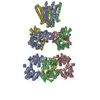

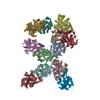
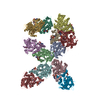

 PDBj
PDBj








